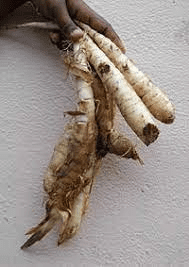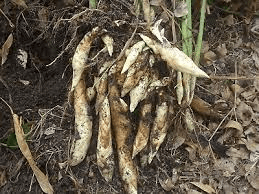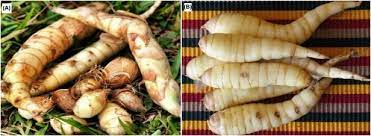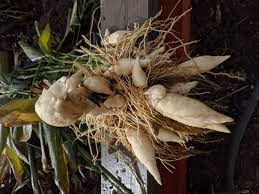Arrowroot rhizomes, scientifically known as Maranta arundinacea, are starchy tubers harvested from the arrowroot plant, a tropical perennial herb native to South America.
These rhizomes serve as a valuable source of a gluten-free starch that has been utilized for centuries in various culinary and medicinal applications.
Arrowroot plants typically thrive in warm, humid climates with well-drained soil, and their rhizomes are harvested when the plant reaches maturity, usually after about 10 to 12 months of growth.
The arrowroot rhizomes are characterized by their high starch content, which makes them ideal for thickening sauces, soups, and gravies in cooking.
Unlike some other starches, arrowroot starch remains stable when exposed to acidic ingredients, making it a preferred choice for recipes that require prolonged heating or acidic components.
Additionally, arrowroot starch is renowned for its smooth texture and neutral flavor, which allows it to seamlessly blend into various dishes without altering their taste significantly.
Beyond its culinary uses, arrowroot rhizomes have also been traditionally valued for their medicinal properties. In traditional medicine systems such as Ayurveda, arrowroot powder is believed to possess soothing and healing properties, making it a common ingredient in remedies for digestive issues, diarrhea, and skin ailments.
Furthermore, arrowroot starch is often utilized in natural skincare products for its ability to absorb excess oil and moisture, leaving the skin feeling soft and refreshed.
The cultivation of arrowroot plants and the extraction of their rhizomes play a significant role in supporting livelihoods in many tropical regions.
Small-scale farmers often cultivate arrowroot as a cash crop, providing a sustainable source of income for rural communities. Additionally, the demand for arrowroot starch continues to grow, driven by the rising popularity of gluten-free and natural food products in global markets.
The Economic Importance and Uses of Arrowroot Rhizomes

1. Food Industry: Arrowroot rhizomes serve as a valuable ingredient in the food industry, offering various culinary applications. They are commonly used as a thickening agent in soups, sauces, and gravies due to their superior thickening properties compared to other starches. Additionally, arrowroot powder is gluten-free, making it a preferred choice for individuals with gluten intolerance or celiac disease.
2. Medicine: In traditional medicine, arrowroot rhizomes are utilized for their medicinal properties. They are believed to possess digestive benefits and are often used to alleviate symptoms of diarrhea and indigestion. Arrowroot is also considered a demulcent, meaning it soothes and protects irritated or inflamed mucous membranes in the body.
3. Cosmetics: Arrowroot powder is a common ingredient in natural and organic cosmetics. Due to its fine texture and absorbent properties, it is used in talcum powders, dry shampoos, and as a natural alternative to talc in various beauty products. Arrowroot helps absorb excess oil, making it suitable for skincare formulations such as facial masks and powders.
4. Textile Industry: Arrowroot starch is utilized in the textile industry for sizing fabrics. Sizing is a process in textile manufacturing where starch is applied to fabrics to improve their strength, stiffness, and handle during processing. Arrowroot starch provides a smooth and glossy finish to fabrics, enhancing their overall quality.
5. Baby Products: Arrowroot powder is a common ingredient in baby powders and diaper rash creams. Its gentle and soothing properties make it suitable for sensitive skin, providing relief from irritation and inflammation. Arrowroot is preferred over talcum powder due to concerns about the potential health risks associated with talc usage.
6. Baking: Arrowroot flour is often used in gluten-free baking as a substitute for wheat flour. It contributes to the light and airy texture of baked goods while also providing a neutral flavor profile. Arrowroot flour is particularly useful in recipes that require a delicate crumb structure, such as cakes, cookies, and pastries.
7. Natural Remedies: Arrowroot rhizomes are utilized in various natural remedies and herbal preparations. They are known for their soothing and healing properties, making them a common ingredient in poultices, herbal teas, and tinctures. Arrowroot is believed to have anti-inflammatory and analgesic effects, providing relief from minor ailments and discomfort.
8. Pet Care Products: Arrowroot powder is incorporated into pet care products such as dry shampoos and grooming powders for dogs and cats. Its gentle formulation makes it suitable for pets with sensitive skin, helping to absorb excess oil and odors between baths. Arrowroot-based grooming products provide a natural and safe alternative to conventional pet care products.
9. Industrial Applications: Arrowroot starch is utilized in various industrial applications beyond the food and textile industries. It is used as a binding agent in the manufacturing of paper, cardboard, and adhesives. Arrowroot-based adhesives offer a natural and eco-friendly alternative to synthetic adhesives, reducing environmental impact.
10. Herbal Medicine: In traditional herbal medicine systems, arrowroot rhizomes are valued for their medicinal properties. They are used to treat digestive disorders, fevers, and skin conditions. Arrowroot is often incorporated into herbal formulations and dietary supplements aimed at promoting overall health and well-being.
11. Gluten-Free Products: Arrowroot flour is a key ingredient in the production of gluten-free products for individuals with gluten sensitivity or celiac disease. It serves as a versatile alternative to wheat flour in a wide range of culinary applications, including bread, pancakes, and pizza crusts. Arrowroot-based gluten-free products offer consumers safe and nutritious alternatives to traditional wheat-based products.
12. Agriculture: Arrowroot cultivation contributes to agricultural diversity and sustainability in regions where it is grown. The crop requires minimal inputs and is well-suited to tropical and subtropical climates. Arrowroot cultivation provides economic opportunities for farmers and promotes food security by diversifying crop production.
13. Natural Body Powders: Arrowroot powder is a primary ingredient in natural body powders and dusting powders. Its soft and silky texture makes it ideal for use as a body powder to absorb moisture and reduce friction. Arrowroot-based body powders are often scented with essential oils for added fragrance and therapeutic benefits.
14. Culinary Thickeners: Arrowroot starch is prized for its superior thickening properties and clear, glossy appearance when used in culinary applications. It is a popular choice for thickening sauces, puddings, and fruit fillings without imparting a starchy taste or cloudiness. Arrowroot-based thickeners provide a smooth and velvety texture to dishes, enhancing their overall appeal.
15. Herbal Teas: Arrowroot rhizomes are used to prepare herbal teas known for their soothing and calming effects on the digestive system. Arrowroot tea is believed to relieve gastrointestinal discomfort, including diarrhea, bloating, and stomach cramps. It is often consumed as a natural remedy for digestive issues and as a gentle detoxifying beverage.
16. Sustainable Farming Practices: Arrowroot cultivation promotes sustainable farming practices due to its low environmental impact and minimal input requirements. The crop is resilient to pests and diseases, reducing the need for chemical pesticides and fertilizers. Additionally, arrowroot cultivation helps prevent soil erosion and maintains soil health, contributing to long-term agricultural sustainability.
17. Natural Baby Care Products: Arrowroot powder is a key ingredient in natural baby care products such as diaper rash creams and powders. Its gentle and absorbent properties make it suitable for soothing and protecting delicate baby skin. Arrowroot-based baby care products provide parents with a safe and effective alternative to conventional baby care products containing synthetic ingredients.
18. Indigenous Uses: Indigenous communities have long utilized arrowroot rhizomes for various cultural and medicinal purposes. They are valued for their nutritional, medicinal, and ceremonial significance. Arrowroot plays a vital role in indigenous traditions and practices, reflecting the deep connection between people, plants, and the land.
Read Also: The Curry Leaves: Economic Importance, Uses, and By-Products
The Products and By-products That Can Be Derived From Arrowroot Rhizomes

1. Arrowroot Flour: Arrowroot rhizomes are processed to produce arrowroot flour, a fine white powder with various culinary applications. The rhizomes are washed, peeled, and grated, then the starch is extracted through a process of washing and settling. The resulting starch is dried and ground into a smooth flour, which is commonly used as a thickening agent in cooking and baking.
2. Arrowroot Starch: Arrowroot starch is the primary by-product of arrowroot flour production. It is extracted during the washing and settling process and is dried to produce a fine, powdery substance. Arrowroot starch is prized for its superior thickening properties and is used in various industries, including food, pharmaceuticals, and textiles.
3. Arrowroot Powder: Arrowroot powder is another term for arrowroot flour, referring to the finely ground starch extracted from arrowroot rhizomes. It is commonly used as a thickening agent in sauces, gravies, and desserts, as well as a gluten-free alternative to wheat flour in baking.
4. Arrowroot Cookies: Arrowroot flour can be used to make delicious and gluten-free arrowroot cookies. These cookies are light and crispy, with a delicate flavor profile. Arrowroot cookies are a popular snack option for individuals with gluten intolerance or those following a gluten-free diet.
5. Arrowroot Pudding: Arrowroot starch is often used to prepare arrowroot pudding, a smooth and creamy dessert with a silky texture. Arrowroot pudding is typically flavored with vanilla or other natural extracts and can be served warm or chilled.
6. Arrowroot Glaze: Arrowroot starch can be dissolved in water to create a clear and glossy arrowroot glaze. This glaze is commonly used to add shine and moisture to pastries, fruits, and desserts. Arrowroot glaze is preferred over cornstarch-based glazes due to its clarity and neutral flavor.
7. Arrowroot Paper: Arrowroot starch is utilized in the production of arrowroot paper, a type of paper made from plant fibers. The starch acts as a binding agent, helping to hold the paper fibers together and create a smooth surface. Arrowroot paper is used for various applications, including writing, printing, and packaging.
8. Arrowroot Adhesives: Arrowroot starch can be processed into arrowroot-based adhesives used in various industries. These adhesives are eco-friendly alternatives to synthetic adhesives, offering strong bonding properties without harmful chemicals. Arrowroot adhesives are used in woodworking, paper crafts, and other applications.
9. Arrowroot Face Powder: Arrowroot powder is a common ingredient in natural face powders and cosmetics. It is valued for its absorbent properties, which help control excess oil and shine on the skin. Arrowroot face powder provides a smooth and matte finish, making it suitable for all skin types.
10. Arrowroot Shampoo: Arrowroot powder can be used as a natural alternative to talcum powder in dry shampoos. It helps absorb excess oil and refreshes the scalp between washes. Arrowroot shampoo is gentle on the scalp and hair, making it suitable for daily use and for individuals with sensitive skin.
11. Arrowroot Body Powder: Arrowroot powder is used to make natural body powders and dusting powders. These powders help absorb moisture and reduce friction on the skin, keeping it dry and comfortable. Arrowroot body powder is often scented with essential oils for added fragrance and therapeutic benefits.
12. Arrowroot Dog Shampoo: Arrowroot powder can be incorporated into natural dog shampoos and grooming products. Its absorbent properties help remove excess oil and dirt from the dog’s coat, leaving it clean and fresh. Arrowroot dog shampoo is gentle on the skin and fur, making it suitable for dogs with sensitive skin.
13. Arrowroot Diaper Rash Cream: Arrowroot powder is a key ingredient in natural diaper rash creams for babies. Its soothing and healing properties help relieve diaper rash and protect the baby’s delicate skin. Arrowroot diaper rash cream forms a protective barrier against moisture and irritants, promoting faster healing.
14. Arrowroot Herbal Tea: Arrowroot rhizomes can be used to prepare herbal tea known for its soothing and digestive benefits. Arrowroot tea is believed to relieve gastrointestinal discomfort and promote overall digestive health. It can be consumed hot or cold and may be flavored with herbs or spices for added taste.
15. Arrowroot Body Butter: Arrowroot powder can be incorporated into homemade body butter recipes. Its absorbent properties help thicken the butter and give it a smooth texture. Arrowroot body butter moisturizes and nourishes the skin, leaving it soft and supple.
16. Arrowroot Facial Mask: Arrowroot powder can be mixed with other natural ingredients to create a homemade facial mask. The mask helps absorb excess oil, unclog pores, and improve skin tone and texture. Arrowroot facial masks are gentle and suitable for all skin types.
17. Arrowroot Herbal Poultice: Arrowroot rhizomes can be ground into a paste and applied topically as a herbal poultice. The poultice helps reduce inflammation, soothe minor skin irritations, and promote wound healing. Arrowroot herbal poultices are commonly used in traditional herbal medicine practices.
18. Arrowroot Plant-Based Milk: Arrowroot rhizomes can be used to make plant-based milk alternatives. The rhizomes are blended with water and strained to produce a creamy and nutritious arrowroot milk. Arrowroot milk can be used as a dairy-free alternative in recipes, cereals, and beverages.
These diverse products and by-products derived from arrowroot rhizomes highlight the versatility and value of this plant in various industries, from food and cosmetics to pharmaceuticals and beyond.
Read Also: Storage Life of Harvested Crop Materials
Frequently Asked Questions (FAQ’s) About Arrowroot Rhizomes

1. What is Arrowroot?
Arrowroot is a starchy root derived from the rhizomes of the Maranta arundinacea plant, native to tropical regions of South America. It is cultivated for its edible tubers, which are processed into arrowroot flour or starch. Arrowroot has been used for centuries in cooking, traditional medicine, and various industries due to its versatile properties.
2. How is Arrowroot Used in Cooking?
Arrowroot is commonly used as a thickening agent in cooking and baking. Its fine texture and neutral flavor make it ideal for thickening sauces, gravies, soups, and desserts. Arrowroot flour or starch is often preferred over other starches due to its superior thickening power and clear, glossy appearance in cooked dishes.
3. Is Arrowroot Gluten-Free?
Yes, arrowroot is naturally gluten-free, making it a suitable alternative for individuals with gluten intolerance or celiac disease. Arrowroot flour or starch can be used as a substitute for wheat flour in gluten-free recipes, providing similar thickening properties without the risk of gluten contamination.
4. What are the Health Benefits of Arrowroot?
Arrowroot is valued for its various health benefits, including its digestive properties. It is believed to soothe the digestive system and alleviate symptoms of diarrhea, indigestion, and other gastrointestinal issues. Arrowroot is also considered a demulcent, meaning it helps protect and soothe irritated mucous membranes in the body.
5. Can Arrowroot be Used in Cosmetics?
Yes, arrowroot powder is commonly used in natural and organic cosmetics. Its fine texture and absorbent properties make it suitable for use in talcum powders, dry shampoos, and facial masks. Arrowroot helps absorb excess oil and moisture from the skin and hair, leaving them feeling smooth and refreshed.
6. How is Arrowroot Cultivated?
Arrowroot is typically cultivated in tropical and subtropical regions with well-draining soil and high humidity. The rhizomes are planted directly in the soil or in raised beds, and they require regular watering and partial shade. Arrowroot plants can be harvested after about 10-12 months when the rhizomes reach maturity.
7. Where Can I Purchase Arrowroot Products?
Arrowroot flour, starch, and other products derived from arrowroot rhizomes are available in health food stores, specialty grocery stores, and online retailers. These products may be sold in bulk or packaged forms, and they are commonly used in gluten-free cooking, natural skincare, and herbal remedies.
Read Also: Top 20 Proven Benefits of Ginger Plant

